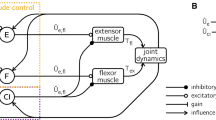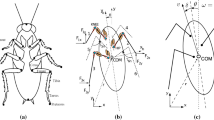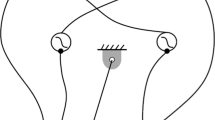Abstract
Neuromuscular systems are stabilized and controlled by both feedforward and feedback signals. Feedforward pathways driven by central pattern generators (CPGs), in conjunction with preflexive mechanical reaction forces and nonlinear muscle properties, can produce stable stereotypical gaits. Feedback is nonetheless present in both slow and rapid running, and preflexive mechanisms can join with neural reflexes originating in proprioceptive sensors to yield robust behavior in uncertain environments. Here, we develop a single degree-of-freedom neuromechanical model representing a joint actuated by an agonist/antagonist muscle pair driven by motoneurons and a CPG in a periodic rhythm characteristic of locomotion. We consider two characteristic feedback modes: phasic and tonic. The former encodes states such as position in the timing of individual spikes, while the latter can transmit graded measures of force and other continuous variables as spike rates. We use results from phase reduction and averaging theory to predict phase relationships between CPG and motoneurons in the presence of feedback and compare them with simulations of the neuromechanical model, showing that both phasic and tonic feedback can shift motoneuronal timing and thereby affect joint motions. We find that phase changes in neural activation can cooperate with preflexive displacement and velocity effects on muscle force to compensate for externally applied forces, and that these effects qualitatively match experimental observations in the cockroach.
Similar content being viewed by others

References
Ahn AN, Full RJ (2002) A motor and a brake: two leg extensor muscles acting at the same joint manage energy differently in a running insect. J Exp Biol 205: 379–389
Ahn AN, Meijer K, Full RJ (2006) In situ muscle power differs without varying in vitro mechanical properties in two insect leg muscles innvervated by the same motor neuron. J Exp Biol 209: 3370–3382
Akay T, Büschges A (2006) Load signals assist the generation of movement-dependent reflex reversal in the femur–tibia joint of stick insects. J Neurophysiol 96: 3352–3537
Akay T, Bässler U, Gerharz P, Büschges A (2001) The role of sensory signals from the insect coxa-trochanteral joint in controlling motor activity of the femur–tibia joint. J Neurophys 85(2): 594–604
Akay T, Haehn S, Schmitz J, Büschges A (2004) Signals from load sensors underlie interjoint coordination during stepping movements of the stick insect leg. J Neurophysiol 92: 42–51
Borgmann A, Hooper SL, Büschges A (2009) Sensory feedback induced by front-leg stepping entrains the activity of central pattern generators in caudal segments of the stick insect walking system. J Neurosci 29(9): 2972–2983
Brown IE, Scott SH, Loeb GE (1995) “Preflexes”—programmable, high-gain, zero-delay intrinsic responses of perturbed musculoskeletal systems. Soc Neurosci Abstr 21: 562.9
Büschges A (1998) Inhibitory synaptic drive patterns motoneuronal activity in rhythmic preparations of isolated thoracic ganglia in the stick insect. Brain Res 783: 262–271
Büschges A, Ludwar BC, Bucher D, Schmidt J, DiCaprio RA (2004) Synaptic drive contributing to rhythmic activation of motoneurons in the deafferented stick insect walking system. Eur J Neurosci 12: 1856–1862
Büschges A, Akay T, Gabriel JP, Schmidt J (2008) Organizing network action for locomotion: insights from studying insect walking. Brain Res Rev 57: 162–171
Connor J, Walter D, McKown R (1977) Neural repetitive firing: modifications of the Hodgkin–Huxley axon suggested by experimental results from crustacean axons. Biophys J 18: 81–102
Delcomyn F (1991a) Perturbation of the motor system in freely walking cockroaches I. Rear leg amputation and the timing of motor activity in leg muscles. J Exp Biol 156: 483–502
Delcomyn F (1991b) Perturbation of the motor system in freely walking cockroaches II. The timing of motor activity in leg muscles after amputation of a middle leg. J Exp Biol 156: 503–517
Ekeberg Ö (1993) A combined neuronal and mechanical model of fish swimming. Biol Cybern 69: 363–374
Ekeberg Ö, Grillner S (1999) Simulations of neuromuscular control in lamprey swimming. Phil Trans R Soc B 354: 895–902
Ekeberg Ö, Pearson K (2005) Computer simulation of stepping in the hind legs of the cat: an examination of mechanisms regulating the stance-to-swing transition. J Neurophysiol 94: 4256–4268
Ekeberg Ö, Grillner S, Landsner A (1995) The neural control of fish swimming studied through numerical simulations. Adapt Behav 3: 363–384
Ekeberg Ö, Blumel M, Büschges A (2004) Dynamic simulation of insect walking. Arthropod Struct Dev 33: 287–300
French AS, Wong RKS (1976) The responses of trochanteral hair plate sensilla in the cockroach to periodic and random displacements. Biol Cybern 22: 33–38
Fuchs E (2009) Personal communication. Princeton University, Princeton
Full RJ, Koditschek DE (1999) Templates and anchors: neuromechanical hypotheses of legged locomotion on land. J Exp Biol 202: 3325–3332
Gabriel JP, Büschges A (2007) Control of stepping velocity in a single insect leg during walking. Philos Trans R Soc Lond A 365: 251–271
Ghigliazza RM, Holmes P (2004a) A minimal model of a central pattern generator and motoneurons for insect locomotion. SIAM J Appl Dyn Syst 3(4): 671–700
Ghigliazza RM, Holmes P (2004b) Minimal models of bursting neurons: how multiple currents, conductances and timescales affect bifurcation diagrams. SIAM J Appl Dyn Syst 3(4): 636–670
Guckenheimer J (1975) Isochrons and phaseless sets. J Math Biol 1: 259–273
Guckenheimer J, Holmes P (1983) Nonlinear oscillations, dynamical systems, and bifurcations of vector fields. Springer, New York
Hatze H (1977) A myocybernetic control model of skeletal muscle. Biol Cybern 25: 103–119
Hatze H (1978) General myocybernetic control model of skeletal muscle. Biol Cybern 28: 143–157
Hill AV (1938) The heat of shortening and the dynamic constants of muscle. Proc R Soc Lond B 126: 136–195
Hodgkin A, Huxley A (1952) A quantitative description of membrane current and its application to conduction and excitation in nerve. J Physiol 117: 500–544
Holmes P, Full RJ, Koditschek D, Guckenheimer J (2006) The dynamics of legged locomotion: models, analyses and challenges. SIAM Rev 48(2): 207–304
Hoppensteadt FC, Izhikevich EM (1997) Weakly connected neural networks. Springer, New York
Jindrich DL, Full RJ (2002) Dynamic stabilization of rapid hexapedal locomotion. J Exp Biol 205: 2803–2823
Kotaleski JH, Grillner S, Lansner A (1999a) Neural mechanisms potentially contributing to the intersegmental phase lag in lamprey I. Segmental oscillations dependent on reciprocal inhibition. Biol Cybern 81: 317–330
Kotaleski JH, Lansner A, Grillner S (1999b) Neural mechanisms potentially contributing to the intersegmental phase lag in lamprey II. Hemisegmental oscillations produced by mutually coupled excitatory neurons. Biol Cybern 81: 299–315
Kukillaya RP, Holmes P (2007) A hexapedal jointed-leg model for insect locomotion in the horizontal plane. Biol Cybern 97(5–6): 379–395
Kukillaya RP, Holmes P (2009) A model for insect locomotion in the horizontal plane: feedforward activation of fast muscles, stability, and robustness. J Theor Biol 261(2): 210–226
Kukillaya RP, Proctor J, Holmes P (2009) Neuro-mechanical models for insect locomotion: stability, maneuverability, and proprioceptive feedback. CHAOS: Interdiscip J Nonlinear Sci 19(2): 026107
Lehman W, Szent-Görgyi AG (1975) Regulation of muscular contraction. J Gen Physiol 66: 1–30
Loeb GE, Brown IE, Cheng EJ (1999) A hierarchical foundation for models of sensorimotor control. Exp Brain Res 126(1): 1–18
Malkin IG (1949) Methods of Poincaré and Linstedt in the theory of nonlinear oscillations. Gostexisdat, Moscow (in Russian)
Malkin IG (1956) Some problems in nonlinear oscillation theory. Gostexisdat, Moscow (in Russian)
Marder E (2000) Motor pattern generation. Curr Opin Neurobiol 10(6): 691–698
McMillen T, Williams TL, Holmes P (2008) Nonlinear muscles, passive viscoelasticity and body taper conspire to create neuro-mechanical phase lags in anguilliform swimmers. PLoS Comput Biol 4(8): e1000157
Noah JA, Quimby L, Frazier SF, Zill SN (2004) Sensing the effect of body load in legs: responses of tibial campaniform sensilla to forces applied to the thorax in freely standing cockroaches. J Comp Physiol A 190: 201–215
Pearson KG (1972) Central programming and reflex control of walking in the cockroach. J Exp Biol 56: 173–193
Pearson KG (1995) Proprioceptive regulation of locomotion. Curr Opin Neurobiol 5: 786–791
Pearson KG (2000) Motor systems. Curr Opin Neurobiol 10: 649–654
Pearson KG, Fourtner CR (1975) Nonspiking interneurons in walking system of the cockroach. J Neurophysiol 38: 33–51
Pearson KG, Iles JF (1970) Discharge patterns of coxal levator and depressor motoneurons of the cockroach, Periplaneta americana. J Exp Biol 52: 139–165
Pearson KG, Iles JF (1973) Nervous mechanisms underlying intersegmental co-ordination of leg movements during walking in the cockroach. J Exp Biol 58: 725–744
Pearson KG, Wong RKS, Fourtner CR (1976) Connexions between hair-plate afferents and motoneurones in the cockroach leg. J Exp Biol 64: 251–266
Pearson K, Ekeberg Ö, Büschges A (2006) Assessing sensory function in locomotor systems using neuro-mechanical simulations. Trends Neurosci 29(11): 625–631
Rose R, Hindmarsh J (1989) The assembly of ionic currents in a thalamic neuron I. The three-dimensional model. Proc R Soc Lond B 237: 267–288
Schmitt J, Holmes P (2000a) Mechanical models for insect locomotion: dynamics and stability in the horizontal plane—application. Biol Cybern 83(6): 517–527
Schmitt J, Holmes P (2000b) Mechanical models for insect locomotion: dynamics and stability in the horizontal plane—theory. Biol Cybern 83(6): 501–515
Seipel JE, Holmes P, Full RJ (2004) Dynamics and stability of insect locomotion: a hexapedal model for horizontal plane motions. Biol Cybern 91(2): 76–90
Sponberg S, Full RJ (2008) Neuromechanical response of musculo-skeletal structures in cockroaches during rapid running on rough terrain. J Exp Biol 211: 433–446
Tryba AK, Ritzmann RE (2000a) Multi-joint coordination during walking and foothold searching in the Blaberus cockroach. I. Kinematics and electromyograms. J Neurophysiol 83: 3323–3336
Tryba AK, Ritzmann RE (2000b) Multi-joint coordination during walking and foothold searching in the Blaberus cockroach. II. Extensor motor neuron pattern. J Neurophysiol 83: 3337–3350
Watson JT, Ritzmann RE (1998a) Leg kinematics and muscle activity during treadmill running in the cockroach, Blaberus discoidalis: I. Slow running. J Comp Physiol A 182: 11–22
Watson JT, Ritzmann RE (1998b) Leg kinematics and muscle activity during treadmill running in the cockroach, Blaberus discoidalis: II. Fast running. J Comp Physiol A 182: 23–33
Williams TL, Bowtell G, Curtin NA (1998) Predicting force generation by lamprey muscle during applied sinusiodal movement using a simple dynamic model. J Exp Biol 201: 869–875
Wilson DM (1965) Proprioceptive leg reflexes in cockroaches. J Exp Biol 43: 397–409
Winfree AT (2001) The geometry of biological time, 2nd edn. Springer, New York
Wong RKS, Pearson KG (1976) Properties of the trochanteral hair plate and its function in the control of walking in the cockroach. J Exp Biol 64: 233–249
Zajac FE (1989) Muscle and tendon: properties, models, scaling, and application to biomechanics and motor control. CRC Crit Rev Lett Biomed Eng 17: 359–411
Zill SN, Moran DT (1981a) The exoskeleton and insect proprioception I. Responses of tibial campaniform sensilla to external and muscle-generated force in the American cockroach, Periplaneta americana. J Exp Biol 91: 1–24
Zill SN, Moran DT (1981b) The exoskeleton and insect proprioception III. Activity of tibial campaniform sensilla during walking in the American cockroach, Periplaneta americana. J Exp Biol 94: 57–75
Zill SN, Moran DT, Varela FG (1981) The exoskeleton and insect proprioception II. Reflex effects of tibial campaniform sensilla in the American cockroach, Periplaneta americana. J Exp Biol 94: 43–55
Zill SN, Ridgel AL, DiCaprio RA, Frazier SF (1999) Load signalling by cockroach trochanteral campaniform sensilla. Brain Res 822: 271–275
Author information
Authors and Affiliations
Corresponding author
Rights and permissions
About this article
Cite this article
Proctor, J., Holmes, P. Reflexes and preflexes: on the role of sensory feedback on rhythmic patterns in insect locomotion. Biol Cybern 102, 513–531 (2010). https://doi.org/10.1007/s00422-010-0383-9
Received:
Accepted:
Published:
Issue Date:
DOI: https://doi.org/10.1007/s00422-010-0383-9



